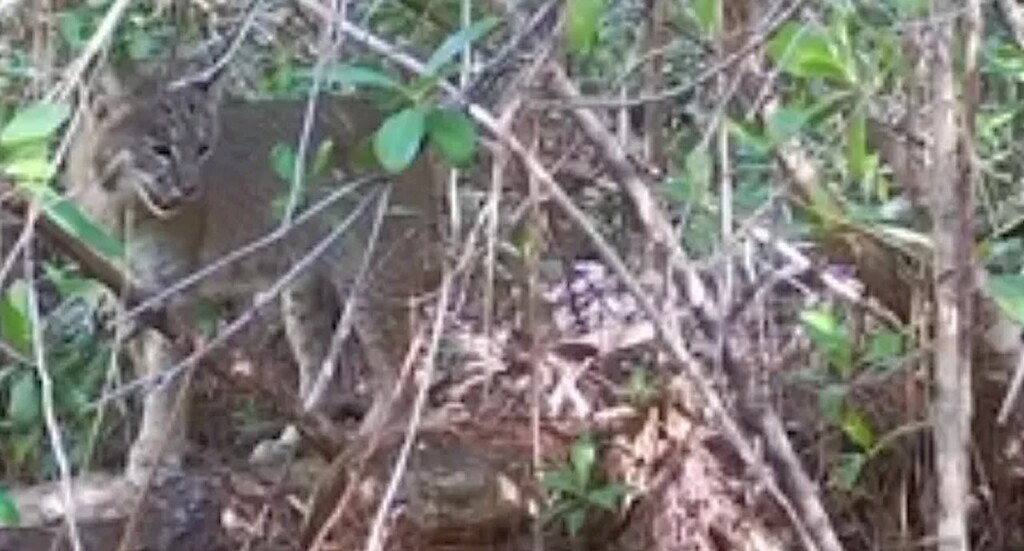 Trail camera image shows bobcat returning to python kill site – Credit: Conservancy of Southwest Florida
Trail camera image shows bobcat returning to python kill site – Credit: Conservancy of Southwest FloridaIn the face of invasive Burmese pythons, even the American alligator of the Everglades is no match.
But one native species isn’t willing to roll over and let the pythons have the run of the famous Florida ecosystem, and has recently been proven capable of mounting a lethal defense of its home.
Meet the American bobcat, which was recently been seen in trail camera footage to have returned to the site of a decapitated python carcass identified by the Conservancy of Southwest Florida which had been tracking it as a way of locating fertile female pythons for removal.
The conservancy followed the radio signal of a collar around the 13-foot-long snake, which they had nicknamed Loki after a nefarious Norse mythological deity who was punished for mischief by being chained to the ground of a cave under a serpent whose venom slowly dripped from its fangs down onto Loki’s head.
Arriving at the source of the radio signals near the city of Naples, conservationists discovered that Loki the snake had lost his own head, and had been buried under pine needles nearby. Setting up some trail cams, it didn’t take long for them to identify the predator.
“A 25-pound cat killed and cached a 52-pound python? That’s a win for the home team,” says Ian Bartoszek, a wildlife biologist with Conservancy who found Loki’s remains, to Gulf Coast News. “We all tend to like animals that punch above their weight class. Here was a native animal pushing back against an invasive apex predator.”
Bobcats have also become prey to these large snakes, showing the relationship is a mutual meal plan, but Florida panthers, black bears, and even some predatory birds, have all begun to take Burmese pythons as prey.
“There’s a bit of a pattern emerging that—and you’d expect as much—over time, the ecosystem is rebalancing itself. It’s fighting back,” Bartoszek told Live Science. “These native predators are recognizing Burmese pythons as a new food source and are able to take advantage of some of their vulnerabilities.”
OTHER STORIES LIKE THIS: Out-of-Control Invasive Crab Species Has Met its Match: Cute and Hungry Otters
It’s been around 4 decades since Burmese pythons were brought to America as part of the illegal wildlife trade in pets and released into the Everglades. They’ve decimated local wildlife, including raccoons and other mammals, and the reason Loki was radio collared was because he was a “scout.”
 Wildlife biologists Ian Bartoszek (front) and Ian Easterling sit with a 15-foot female python – credit, Conservancy of Southwest Florida
Wildlife biologists Ian Bartoszek (front) and Ian Easterling sit with a 15-foot female python – credit, Conservancy of Southwest FloridaIn other conservation lingo, Loki would be referred to as a “Judas” snake but the principle is the same.
Breeding in the spring, a female python can lay up to 100 eggs, and so mature males are identified, radio collared, and followed during the breeding season right to the burrows of the females, who are then euthanized.
SNAKE WRANGLING: Revolutionary Antidote Neutralizes Venom of 19 of World’s Deadliest Snakes–Thanks to Man Who Immunized Himself
Hunters and locals are encouraged to euthanize or hunt snakes without a permit on public lands. Given landowner’s permission is secured, the same is also encouraged on private land. Decapitation is the best method, or simple a bonk on the head with a long heavy pole.
For those not up to the task, they can call the Florida Fish and Wildlife Conservation Commission’s exotic species hotline.
SHARE How The Everglades Is Fighting Back Against The Snakes…
Source link

